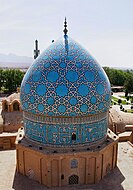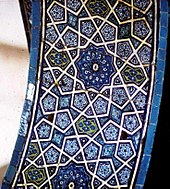History of art - European - Middle Eastern - Siberian-Eskimo
European
Medieval
With the decline of the Roman Empire, the Medieval era began, lasting for a millennium. Early Christian art begins the period, followed by Byzantine art, Anglo-Saxon art, Viking art, Ottonian art, Romanesque art and Gothic art, with Islamic art dominating the eastern Mediterranean.
In Byzantine and Gothic art of the Middle Ages, the dominance of the church resulted in a large amount of religious art. There was extensive use of gold in paintings, which presented figures in simplified forms.
 Empress Theodora and attendants, a example of Byzantine mosaic from Basilica of San Vitale(Ravenna, Italy)
Empress Theodora and attendants, a example of Byzantine mosaic from Basilica of San Vitale(Ravenna, Italy) Similar plaques of whale bone carved with confronted monster heads are found frequently in the graves of wealthy Viking women in Norway. The monster heads, similar to the figureheads attached to Viking ship prows, are typical of Viking decoration. 8th-late 9th century, whale bone, 22 × 18.3 × 0.8 cm (8.6 × 7.2 × 0.3 in), in Walters Art Museum
Similar plaques of whale bone carved with confronted monster heads are found frequently in the graves of wealthy Viking women in Norway. The monster heads, similar to the figureheads attached to Viking ship prows, are typical of Viking decoration. 8th-late 9th century, whale bone, 22 × 18.3 × 0.8 cm (8.6 × 7.2 × 0.3 in), in Walters Art Museum Lisbjerg gold altar, Viking artwork
Lisbjerg gold altar, Viking artwork Byzantine monumental Church mosaics are one of the great achievements of medieval art. These are from Monreale in Sicilyfrom the late 12th century
Byzantine monumental Church mosaics are one of the great achievements of medieval art. These are from Monreale in Sicilyfrom the late 12th century Detail of The Effects of Good Government, a fresco in the City Hall of Siena by Ambrogio Lorenzetti, 1338
Detail of The Effects of Good Government, a fresco in the City Hall of Siena by Ambrogio Lorenzetti, 1338
Renaissance and Baroque
The Renaissance is the return to a valuation of the material world, and this paradigm shift is reflected in art forms, which show the corporeality of the human body, and the three-dimensional reality of landscapes. Art historians often periodize Renaissance art by century, especially with Italian art.Italian Renaissance and Baroque art is traditionally referred to by centuries: trecento for the fourteenth century, quattrocento for the fifteenth, cinquecento for the sixteenth, and seicento for the seventeenth.
 Hieronymus Bosch, The Garden of Earthly Delights, oil on oak panels, 220 cm × 389 cm (87 in × 153 in), Museo del Prado (Madrid, Spain)
Hieronymus Bosch, The Garden of Earthly Delights, oil on oak panels, 220 cm × 389 cm (87 in × 153 in), Museo del Prado (Madrid, Spain) Leonardo da Vinci, Mona Lisa, c. 1503–06, perhaps continuing until c. 1517, oil on poplar panel, Louvre
Leonardo da Vinci, Mona Lisa, c. 1503–06, perhaps continuing until c. 1517, oil on poplar panel, Louvre Michelangelo, The Last Judgment (Michelangelo), 1536–1541, fresco, 13.7 m × 12 m (539.3 in × 472.4 in), Sistine Chapel (Vatican City)
Michelangelo, The Last Judgment (Michelangelo), 1536–1541, fresco, 13.7 m × 12 m (539.3 in × 472.4 in), Sistine Chapel (Vatican City) Giuseppe Arcimboldo, Summer, 1572, Kunsthistorisches Museum(Vienna)
Giuseppe Arcimboldo, Summer, 1572, Kunsthistorisches Museum(Vienna)
Neoclassicalism to Realism
The 18th and 19th centuries included Neoclassicism, Romanticism, and Realism in art.
Middle Eastern
Pre-Islamic Arabia
The art of Pre-Islamic Arabia is related to that of neighbouring cultures. Pre-Islamic Yemen produced stylized alabaster heads of great aesthetic and historic charm. Most of the pre-Islamic sculptures are made of alabaster.
Archaeology has revealed some early settled civilizations in Saudi Arabia: the Dilmun civilization on the east of the Arabian Peninsula, Thamud north of the Hejaz, and Kindah kingdom and Al-Magarcivilization in the central of Arabian Peninsula. The earliest known events in Arabian history are migrations from the peninsula into neighbouring areas. In antiquity, the role of South Arabian societies such as Saba (Sheba) in the production and trade of aromatics not only brought such kigdoms wealth but also tied the Arabian peninsula into trade networks, resulting in far-ranging artistic influences.
It seems probable that before around 4000 BC the Arabian climate was somewhat wetter that today, benefitting from a monsoon system that has since moved south. During the late fourth millennium BC permanent settlements began to appear, and inhabitants adjusted to the emerging dryer conditions. In south-west Arabia (modern Yemen) a moister climate supported several kingdoms during the second and first millennia BC. The most famos of these is Sheba, the kingdom of the biblical Queen of Sheba. These societies used a combination of trade in spices and the natural resources of the region, including aromatics such as frankincense and myrrh, to build wealthy kingdoms. Mārib, the Sabaean capital, was well positioned to tap into Mediterranean as well as Near Eastern trade, and in kingdoms to the east, in what is today Oman, trading links with Mesopotamia, Persia and even India were possible. The area was never a part of the Assyrian or Persian empires, and even Babylonian control of north-west Arabia seems to have been relatively short-lived. Later Roman attempts to control the region's lucrative trade foundered. This impenetrability to foreign armies doubtless augmented ancient rulers' bargaining power in the spice and incense trade.
Although subject to external influences, south Arabiaretained characteristics particular to itself. The human figure is typically based on strong, sqare shapes, the fine modeling of detail contrastingwith a stylized simplicity of form.
 The 'Ain Ghazal Statues consist of a framework of twine-tied reeds coverd with plaster. Some are plain; others have painted bands on their faces and bodies, perhaps representing clothing. Some are full-length, around 90 cm. (36 in.) heigh; others are simply armless torsos. Many are gender-neutral; others clearly female, Louvre
The 'Ain Ghazal Statues consist of a framework of twine-tied reeds coverd with plaster. Some are plain; others have painted bands on their faces and bodies, perhaps representing clothing. Some are full-length, around 90 cm. (36 in.) heigh; others are simply armless torsos. Many are gender-neutral; others clearly female, Louvre- Votive alabaster figurines from Yemen that represent seated women and female heads, made between 3rd and 1st century BCE
 Anthropomorphic stele from pre-Islamic Saudi Arabia at National Museum of Korea, one of the iconic artworks for the pre-Islamic art from the Arabic Peninsula
Anthropomorphic stele from pre-Islamic Saudi Arabia at National Museum of Korea, one of the iconic artworks for the pre-Islamic art from the Arabic Peninsula Rising from a roundel, the sculpture represents a priestess who intercedes with the sun goddess on behalf of the donor, Rathadum, Walters Art Museum, Baltimore
Rising from a roundel, the sculpture represents a priestess who intercedes with the sun goddess on behalf of the donor, Rathadum, Walters Art Museum, Baltimore
Islamic
Some branches of Islam forbid depictions of people and other sentient beings, as they may be misused as idols. Religious ideas are thus often represented through geometric designs and calligraphy. However, there are many Islamic paintings which display religious themes and scenes of stories common among the three Abrahamic monotheistic faiths of Islam, Christianity, and Judaism.
The influence of Chinese ceramics has to be viewed in the broader context of the considerable importance of Chinese culture on Islamic arts in general. The İznik pottery (named after İznik, a city from Turkey) is one of the best well-known types of Islamic pottery. It's famous combination between blue and white is a result of that Ottoman court in Istanbul who greatly valued Chinese blue-and-white porcelain.
 A Persian miniature that ilustrates a complex palace scene, 1539–1543, Mir Sayyid Ali
A Persian miniature that ilustrates a complex palace scene, 1539–1543, Mir Sayyid Ali Ayyubid Raqqa ware stoneware glazed jar with overlapping circles grid pattern. Syria, 12th/13th century
Ayyubid Raqqa ware stoneware glazed jar with overlapping circles grid pattern. Syria, 12th/13th century- An archway in the Ottoman Green Mosque, Bursa, Turkey (1424), with a girih 10-point stars and pentagons
 The Shah Nematollah Vali Shrine, Mahan, Iran, 1431. The blue girih-tiled dome contains stars with, from the top, 5, 7, 9, 12, 11, 9 and 10 points in turn. 11-point stars are rare in Islamic art.
The Shah Nematollah Vali Shrine, Mahan, Iran, 1431. The blue girih-tiled dome contains stars with, from the top, 5, 7, 9, 12, 11, 9 and 10 points in turn. 11-point stars are rare in Islamic art. Luxurious Egyptian or Syrian mosque lamp from 14th century, Calouste Gulbenkian Museum(Lisboa, Portugal)
Luxurious Egyptian or Syrian mosque lamp from 14th century, Calouste Gulbenkian Museum(Lisboa, Portugal) Detail of the ceiling in Kukeldash Madrasa, Lyab-i Hauz, Uzbekistan
Detail of the ceiling in Kukeldash Madrasa, Lyab-i Hauz, Uzbekistan Painting of life tree in interior of Shaki Khan palace, National Art Museum of Azerbaijan
Painting of life tree in interior of Shaki Khan palace, National Art Museum of Azerbaijan İznik bottle with roses, carnations, and other flowers, made between circa 1560 and circa 1580, British Museum
İznik bottle with roses, carnations, and other flowers, made between circa 1560 and circa 1580, British Museum
Siberian-Eskimo
The art of the Eskimo people from Siberia is in the exact same style as the Inuit art from Alaska and north Canada. This is because the native Americans traveled through Siberia to Alaska, and later to the rest of the Americas.
Including the Russian Far East, the population of Siberia numbers just above 40 million people. As a result of the 17th-to-19th-century Russian conquest of Siberia and the subsequent population movements during the Soviet era, the demographics of Siberia today is dominated by native speakers of Russian. There remain a considerable number of indigenous groups, between them accounting for below 10% of total Siberian population, which are also genetically related to Indigenous Peoples of the Americas.
 Siberian Yupik mask from Musée du Quai Branly
Siberian Yupik mask from Musée du Quai Branly- Siberian Yupik mask, Musée du Quai Branly
 Siberian Yupik mask for ceremonies, Musée du Quai Branly
Siberian Yupik mask for ceremonies, Musée du Quai Branly- Mask from circa 1850, wood, 49 cm (19 in) high, Musée du Quai Branly
Text is available under the Creative Commons Attribution-ShareAlike License




